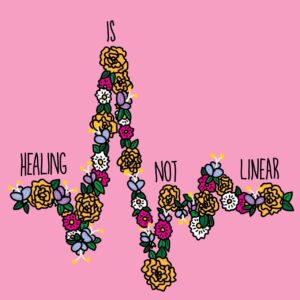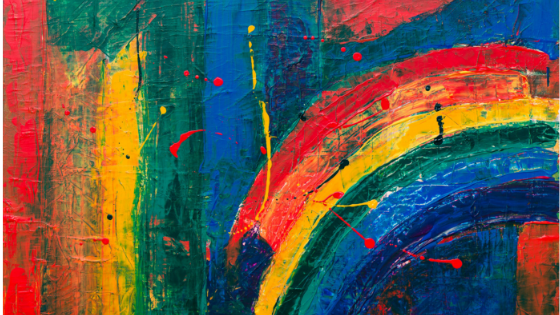Healing isn’t a math problem.
Even though sometimes, with enough rationalizing, it can feel like there just has to be one right answer out there, if someone would just plug in the right numbers. This post is about the team of healers who help me manage my chronic pain, but to understand why my work with healers is so meaningful, you need to first hear two different experiences that painted my perception of healing as reasonable….until it wasn’t.
What it Means to Heal
When I was in my teens, my vision started to blur while I was away from home at a summer poetry camp. My joy at joining the ranks of eyeglasses-wearers was dampened by the addition of other random symptoms, like debilitating headaches and periods that lasted too long. After multiple visits to the endocrionologist, I was diagnosed with a bengin tumor in my pituitary gland (a hyperprolactinoma, to be exact). From then through my early twenties, I took medication twice every day and submitted to regular blood tests and MRI scans to track horomone levels in my brain. This routine continued until I was 23 or 24, when a neuroendocrinologist told me that the tests showed I was in the clear. No more tumor.
What I remember most were the two things that bookended my years of treatment. First, the exhaustion of the initial testing period: Polycystic ovary syndrome? Migraines? Thyroid? MRI, blood draw, pills, repeat, repeat, repeat. But when I finally received a diagnosis, I had a foundation to stand on: I was sick, but I knew what to do to make it right. This satisfaction magnified a thousandfold through the second culminating bookend: a clean bill of health. When I received the good news, I felt as if my adherance to the rules of treatment had earned me my due reward.
A couple years ago, I hit another medical impasse when I developed a mystery pain in my low back. Within the span of a month, I went from some stiffness in my lower back to excrutiating pain when I was sitting or standing. As I had a decade and a half before, I sought out medical guidance in hopes to pin down the dysfunctional culprit in my body, tinker with it, and set it back on its appropriate trajectory of health. I saw doctors. They told me to stop going to spin class, so I stopped going to spin class. The pain continued. I saw more doctors. I spent thousands of dollars seeking the comfort of a diagnosis and a pill or test result or plan that would make everything first make sense and then go away. Except this time, the doctors didn’t see anything.
Doctor Trauma
When I say that I have “doctor trauma,” I mean that whenever I go into a doctor’s office I bring with me the silent baggage of stress and sadness and anger that I’ve accumulated after seeking a diagnosis and hearing repeatedly: “I don’t see anything on the tests.” Sharing the timeline and symptoms and showing my body to strangers never got easier, and the vulnarable process of describing my pain over and over and over without a diagnosis wore down on me. I bordered on depression, feeling gaslit by my own body. Even now, as I prepare to see a new holistic and integrative medicine provider who I know comes on good recommendation, I refuse to garner hope for an actual diagnosis. I’m no longer looking for a diagnosis, because I can’t bear the let down of one more failed attempt at a Hail Mary for the mysterious formula to activate the off switch. Yet, I continue to yearn to heal and thrive.
Where Healers Come In
After hitting wall after wall with traditional doctors in the first year of my chronic pain, I opened myself up to seeing how energy and body work could affect my healing process and my quality of life. Since then, I’ve developed a team of healers who have greatly contributed to my healing, and I want to share who they are and what they do that helps me so much.
I want to acknowledge three things before I get into my positive experiences with nontraditional healing. First, my recommendations are 100% unsponsored. I just really appreciate and have benefited from my sessions with these people, and I want to share and applaud their practice and labor. Second, I do not want to suggest that nontraditional healing is the only or best way for everyone to heal, and I don’t want to shame anyone who benefits from or prefers traditional healing. Third, I want to acknowledge that many healers are not covered by medical insurance, and thus are inaccessible to some folks without expendible income (I pay out of pocket to see all of the healers whom I mention below).
Reiki
Basically, Reiki works to balance out the energetic body which is composed of spinning wheels, known as chakras. As we go through life, bits and pieces of our experiences accumulate in our energetic system. I use Reiki, a safe and loving energy, to essentially flush out those experiences so that everything stays running smoothly and there’s room for new experiences! (excerpted from Anna Joy Sullivan’s description of reiki)
I had a rudimentary knowledge of chakras, enough to know that my root chakra was around my pain point and that it was connected to foundations and safety, things that I’d tenuously coveted throughout my life. When I started to wonder if my pain might be related to energetic blockages, I decided to give reiki a try. I chose to work with Anna Joy Sullivan in fall of 2017 because their approach to their services lines up very well with my personal values: “All spiritual services offered by Anna Joy are approached from a gender-inclusive, nonbinary, queer framework and dedicated to anti-capitalist, anti-oppressive and anti-colonial notions of personal healing and self-actualization.” I’ve seen Anna Joy every two weeks since then, and have expanded from basic reiki sessions to participating in their mentorship program, an experience that we have personalized to a rich and holistic melding of energy work and coaching.
Anna Joy’s practice as a reiki healer to be wholy present with, communicate to, and lovingly clear and guide my chakras is an empowering experience. Our reiki sessions have enabled me to develop a new relationship with the parts of my body that previously felt “broken,” as I’ve learned how to vocalize and visualize the ways my chakras reflect my emotional and energetic healing path. Anna Joy also provides astute write ups for her mentorship clients, so I am able to read back through my progress across our sessions and trace themes and highlights. In addition to clearer chakras, I feel a much greater sense of awareness and lightness in my body.
Massage and Craniosacral Therapy
Like many of the healers I see, Allison Potter, LMT, was introduced to me via recommendation. In addition to her expert physical practice as a massage and craniosacral therapist, Allison can read my body and comunicate what she sees, feels, and senses with a candid kindness and clarity, and she is an excellent listener and holder of space. She’s taught me how to read and recognize the ways that my body responds to things like stress and work and the stages of my mestrual cycle, which enables me to feel like I’m on a team with my chronic pain body (versus feeling like my body is my enemy). When I leave her office I have less physical discomfort, yes, but I also feel embodied, relaxed, and clear in a buzzing, loving kindness manner. Her application of craniosacral therapy is a quiet power, and has provided me with greater insight into how my body will respond well to even seemingly small shifts of direct attention. I feel inspired by Allison’s commitment to reseeing healing as a combination mind/body/spirit activity, and our sessions are one of the highlights of my month. You can contact Allison to set up a craniosacral therapy appointment here.
Iyengar Yoga
I first sought out yoga because I was craving a workout and very much missing moving my body and working my muscles. I hadn’t done yoga since college, and I was nervous about keeping up with a class, so I booked a one-on-one lesson with Suzie Goldstein, the owner of River Valley Yoga. I was immediately (and continue to be) impressed with her individualized approach. Iyengar yoga is focused explicitly on adjusting positions and movements to enable correct alignment, and is described as follows:
The Iyengar method develops strength, endurance, and optimal body alignment, in addition to flexibility and relaxation. The Iyengar method develops self-awareness, intelligent evaluation, and profound inward reflection. The attention to detail and cultivation of awareness is meant to not only maintain physical safety in the practice, but to develop the mental benefits of a complete meditation in action.
Suzie’s knowledge of the intricacies of the body is spectacular, and our one-on-one sessions focus extensively on isolating and training particular muscles in my body so well that I actually replaced physical therapy with our one-on-one sessions. Suzie adjusts our session every time depending on what she reads in my body’s posture and movements and in what I share of my recent experiences with pain and energy, and she intentionally guides and assists me in making shifts into positions that target direct muscles (including sending me home with assigned stretches to practice the following week). Over the many months that I’ve been seeing her, my body has learned to respond with certain movements and postures with more ease. Also, our sessions challenge me in the most satisfying way, so it’s basically like seeing a personal trainer who has a full body approach to healing that includes a holistic awareness of physicality, breath, energy, and progress on an individual level.

The takeaway today is a call for reflection: what would it look like to shift my perspective around what it means to heal, to practice healing, to inhabit healing as an active experience?
Combined together and in addition to weekly EMDR therapy, my reiki, massage and craniosacral therapy, and one-on-one Iyengar yoga sessions have completely shifted my approach to what it means to heal from an illness or pain or disorder. Instead of yearning exclusively for the end result of being future tense healed, I savor the experience of present tense healing for the lessons I continue to learn about mindfulness, intention, self respect and love, acceptance, and presence.
Healing is definitely a process, and while it’s not a linear or mathematic one, I want for there to be ways to make it less traumatic and more meaningful and soft. Here’s a reminder for you by the artist Hana, or Frizz Kid, a mantra the helps me stay present in my healing:

Newsletter
Sign up below to access my free newsletter, Tending with Dr. Kate Henry.

